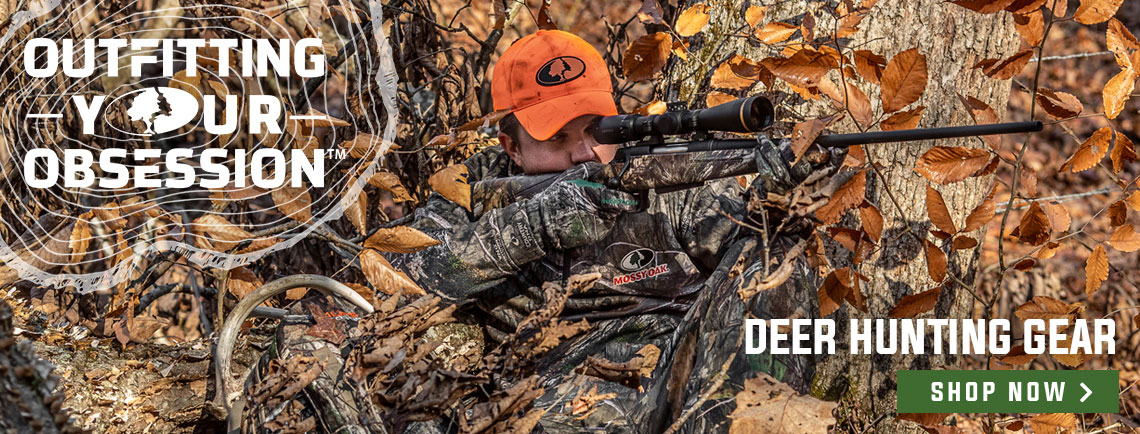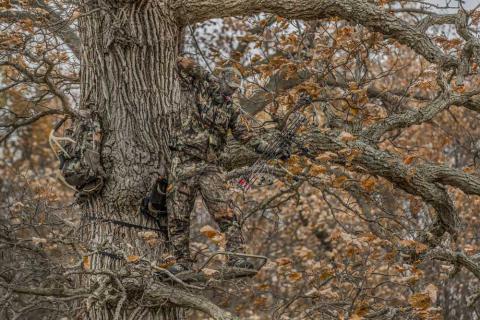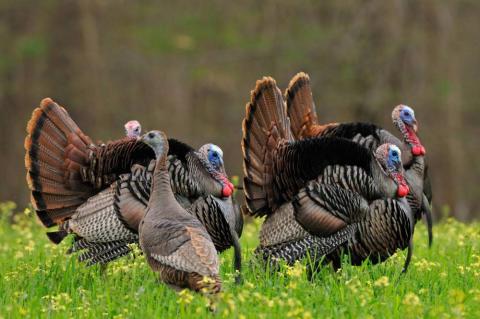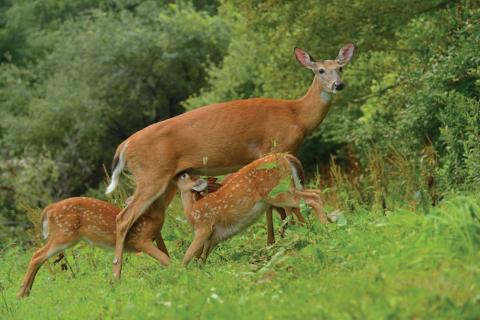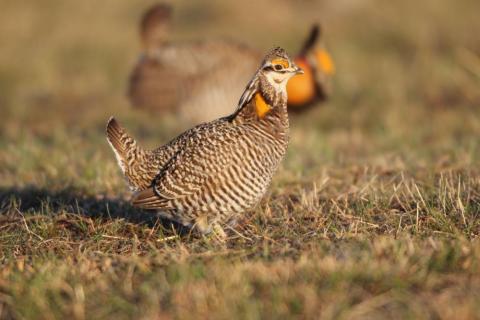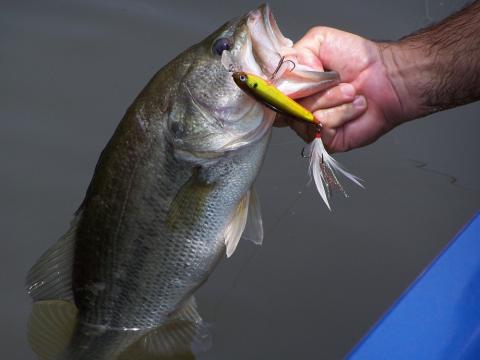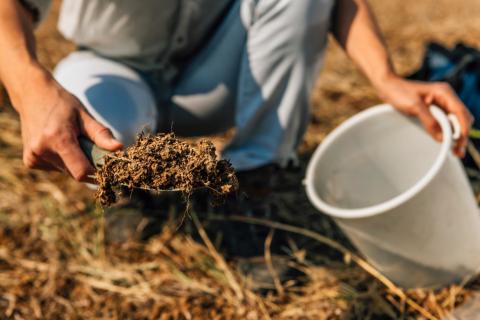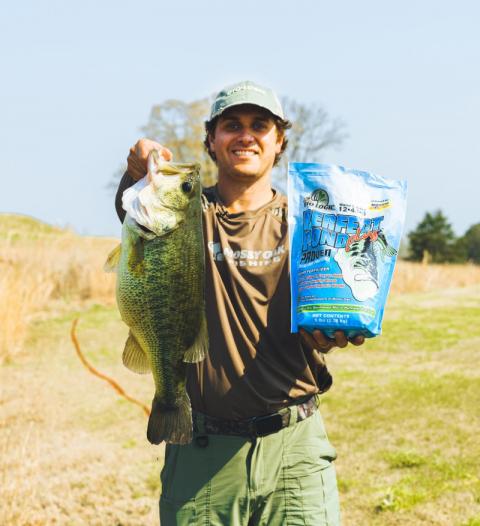provided by John E. Phillips
Keith Pullins of Rapid City, South Dakota, has been a Mossy Oak ProStaffer for the past 8 years. “I’ve been hunting mule deer ever since I first started walking - for about 30 years now.” Pullins has taken 24 mule deer with his bow and 30 with his rifle. His best archery mule deer scored 164 on Pope & Young (P&Y).
Taking Keith Pullins’ Biggest Bow Mule Deer - The Drainage Buck
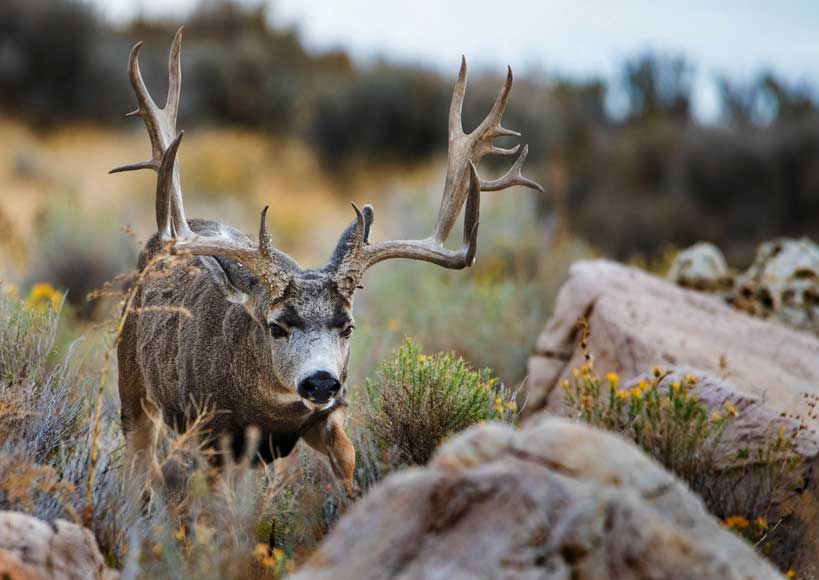
My best P&Y mule deer with a bow scored 164, and I took him on public lands. I found a couple of high elevation points in this area that allowed me to get high and glass a large amount of open prairie. On opening morning of archery season in South Dakota, my buddy, Domanic Heim and I got on two points and spotted this buck grazing with three other bucks. When the three bucks split up, my buck went over a little rise and out of sight. Since he was the biggest of the bucks, I told Domanic, “I’m going to give you first crack at that buck. I’ll stay here and watch both ends of the drainage to see if the buck comes out.” Domanic went after this buck and walked the entire length of that drainage but never saw or spooked that muley. When he returned, I told him, “That buck has got to be in that drainage, because he didn’t come out either end.”
The next morning, Domanic and I planned to hunt together again. When I was driving up to the place we were to meet up, Domanic called and said, “Hey! I overslept, and I won’t be able to make the hunt this morning.” I responded with, “Okay! I’ll set up on that large drainage where we saw the big mule deer buck yesterday.” As the sun came up, I spotted the same three bucks we’d seen the morning before, and the biggest buck did the same thing he did on our first hunt - he went over a rise and down into a drainage. I decided to go after him, but I had to circle around the drainage ditch to get the wind in my favor to hunt him without his smelling me. The drainage was probably only 250 yards long, and when I came up over the top of the drainage, I looked down in the bottom and spotted the buck 70 or 80 yards from me feeding. I sat down on the edge of the drainage and watched him as he fed toward me. The buck then bedded-down for a 30-minute nap, got back up and once more started moving toward me.
I used my rangefinder to determine the spot where I hoped the buck would be when I took my shot. The shot would be 52 yards, if the buck continued the path that he was on, coming toward me. When the buck got to my 52-yard place, I was hoping he would stop, but he didn’t. I didn’t want to whistle to him to try and stop him, because I realized he didn’t know that I was watching him. He was headed toward this one lone tree out on this big prairie I was hunting. That buck bedded-down, about 140 yards from me. After he took an hour nap, he got up and started walking down the same trail that he had walked to reach his bedding site. This time, when the buck got to that 52-yard spot that I had ranged earlier, he stopped exactly at the place I’d ranged. I got up on my knees in a fairly windy breeze. I usually practiced shooting my bow out to 100 yards, so I felt confident that I could make the shot. I was drawing my Elite Ritual Bow back with my fixed-blade mechanical Rage broadhead, and I anchored my shot.
Just about the time I reached my anchor point, the buck looked right at me, and I squeezed the trigger on my mechanical release. I knew I had a high-angle shot, because I was pretty high above the buck. As I watched the arrow fly, I was afraid the buck would squat before he jumped, and that my arrow would fly over his back. But I then heard a loud thud that sounded like someone had been hit with a big 2x4. The buck ran up the hill, and I saw the arrow in him. The buck circled around, came down into the drainage and fell over almost exactly where I’d taken the shot. Later, I found that I had hit him right behind the shoulder, and a little high, due to the steep angle from which I was shooting. The arrow double-lunged the buck. I was somewhat surprised the wind hadn’t pushed my arrow off my target slightly.
When I walked off the lip of the drainage down into the bottom, the grass there was fairly tall. So, I had some trouble finding him. Once I finally located him, I put my backpack down beside him, took a picture and sent it to Domanic who was supposed to be hunting that day with me with a quote that said, “Do you recognize this buck?” I immediately got a text back from Domanic saying, “I can’t believe you shot my buck!” Luckily, Domanic didn’t live far from where I was hunting. Since he wanted to see the buck up close and personal, he brought his four-wheeler into the drainage and helped me get the buck out. By the time Domanic had arrived 30 minutes after I called him, I already had field dressed the buck and drug him to an opening to make loading the buck into the four-wheeler easier.
I’ve learned over the years that when hunting mule deer you have to develop a respect for patience. Many times, mule deer on the prairie will bed-down in an undercut on the side of a drainage. If you try to get in close enough to take a shot with your bow, nine times out of 10, you’ll spook the buck. If you’re going on your first mule deer hunt or getting frustrated because you’re spooking more bucks than you’re taking, I’ve found that letting the buck dictate how the hunt goes and being patient enough to let him decide when and where you’ll take him often will allow you to harvest more bucks than you spook.
Hunting a Muley Buck That’s Too Close
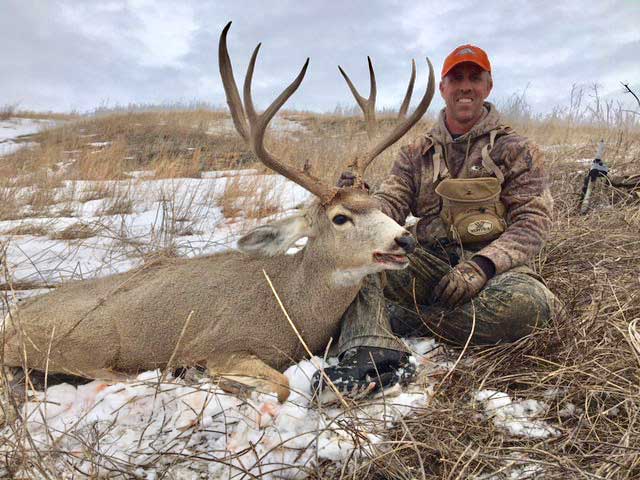
I mentioned before that when you find a mule deer buck bedded in an undercut of a drainage, most of the time you’ve got a better chance of taking him if you just watch him, let him wake up and then try and set up a strategy to get him close enough to take the shot. However, I didn’t follow that rule on the muley buck that was too close to me. Using my spotting scope, I saw this buck in one of those undercuts about a mile away from my vantage point. I could tell there was a little bit of brush on top of that cut bank where the buck was bedded. I thought that if I made the hike to come up behind that bedded buck and got in that brush, I’d have a reasonable chance to arrow him. I had learned that mule deer in my area liked to bed-down in these creek banks where the current had washed out a little cave-like place where the bucks could go in and lay down in that cut bank and be out of the sun. Often there was some moisture in that spot that made the cut bank even cooler.
After I made the mile hike, had the wind in my favor and reached that little patch of brush above the buck, I could tell that the angle that I’d have to shoot wasn’t very good. I backed off a couple of steps and came around the bush I’d been hiding behind. I could tell I then had a better angle to take the shot. I was so close to this buck that when I drew my bow and anchored my shot, the arrow just made a slight little sound. The buck jumped up, and I didn’t get a shot. Most of the time after spooking a buck I replay what happened in my mind. I realized I should have drawn the bow somewhat further back, so that when I came over the drainage, all I would have to do was aim and release the bow. That way, the buck never would have heard me draw, and I probably could have shot the buck, while he was still in the bed.
Something I’ve learned about hunting mule deer for 30 years is that each time I go after them, they teach me new lessons about how to take them or how to spook them. Getting 2 yards away from the buck before I draw my bow is a lesson I won’t forget.
Hunting with a Rifle for My 170 Muley Buck
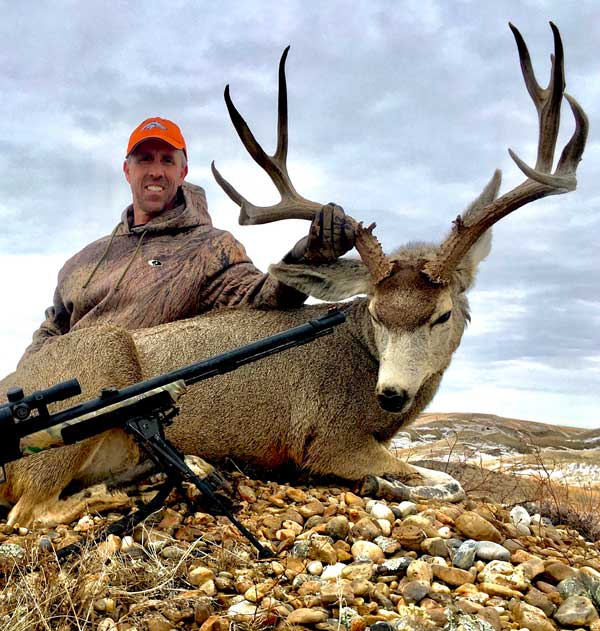
I shot this muley buck the same year I took my biggest archery buck. I was lucky enough to take three big mule deer that year. I was hunting on my wife’s family farm, and we’d been hunting all day long. For the afternoon hunt, we went to a high ridge and started talking about the different places we might hunt. As I was talking, I looked through my spotting scope and found a bedded mule deer buck about 500 yards away. I said, “Hey guys! I think I found a really good buck.” All I could see was the back of the buck, and his head was facing away from me. This buck was all the way across a canyon, so I decided to go down that drainage and try and look for what kind of angle I could get on this buck to take a shot. Every 100 yards, I’d check the buck and make sure he was still bedded where I’d seen him earlier and to see the angle of the shot I would have to make if I took him in his bed. Finally, after my third stop, I saw that I had a broadside shot at the buck – 300 yards away from me. I felt pretty confident in taking that shot because I already had taken mule deer bucks at 400-plus yards.
I was shooting a Weatherby .270 Short Mag. I was using a Vortex Scope and binoculars. I had a bipod on my rifle to provide a steady rest to take the shot. Where I hunted had a lot of prairie ground, and I really believed a quality bipod would make the difference on whether I’d get my buck or miss him, especially when taking long shots. I pulled my bipod legs out, pushed my rifle right up to the crest of the hill and then laid prone for a couple of seconds, trying to catch my breath before I made the shot. Oftentimes, eastern hunters who come west to hunt forget that when making a long hike or climbing up a steep hill, you need to catch your breath and delay your shot until you can be steady before you squeeze the trigger.
Once I squeezed the trigger, I saw that the bullet hit the buck right where I wanted. I was below the buck, and when the bullet entered the buck, it broke his spine and took out his lungs. The buck never moved after that. My wife’s cousin, Carey, watched the whole thing. I knew that I had to cross the canyon to get the buck, and Carey already had covered the 200 yards from where he’d been watching me take the shot. The two of us went down the canyon, across the bottom and climbed up the other side of the canyon to reach my buck. When we got to the deer, I called an adjacent landowner and asked for permission to bring a vehicle onto his property to get my mule deer out. Even though we had to drag the deer to the car, this was much easier then dragging the deer through the canyon, across the bottom and up the hill where the rest of the family was waiting.
My wife’s family owns 2,000 acres of private land, and they know and are friends with all the adjacent landowners. So, obtaining permission to go on the other landowner’s property to get my buck out wasn’t any problem. Most of the public hunting land I hunt is in the National Grasslands. This public hunting area is about 10 miles long and 10 miles wide, with plenty of room for everyone to hunt. The U.S. Forest Service oversees this grassland. I have plenty of both public and private lands to hunt around my home for mule deer.
Anyone coming to the West from the East must know the boundary lines of the property they’re planning to hunt. After they pick out the place where they’ll hunt mule deer, if they’re hunting close to private land, I strongly recommend that they learn the name and phone number of the private landowners near the public lands. If you wound a mule deer buck, and he goes from public land to private land, you’ll need the permission of the landowner before you retrieve your buck.
I’m often asked, “How much hunting pressure does the public land you hunt receive?” During bow season, there’s not much pressure, but in rifle season, this public land receives plenty of hunting pressure. I’ve learned that the only way to find a nice mule deer buck to hunt is to put miles on your boots to get away from any access points. Sometimes you only have to get 300 yards off a public road to pinpoint some deep draws where the mule deer bucks will hide. However, often I’ll go several miles before daylight where I can glass a property and see down in that grass a buck to hunt. The reason I mention the grasslands and how to hunt them is that I took two of my three bucks that scored over 160 on public lands.
Bagging a Blackpowder Mule Deer Buck
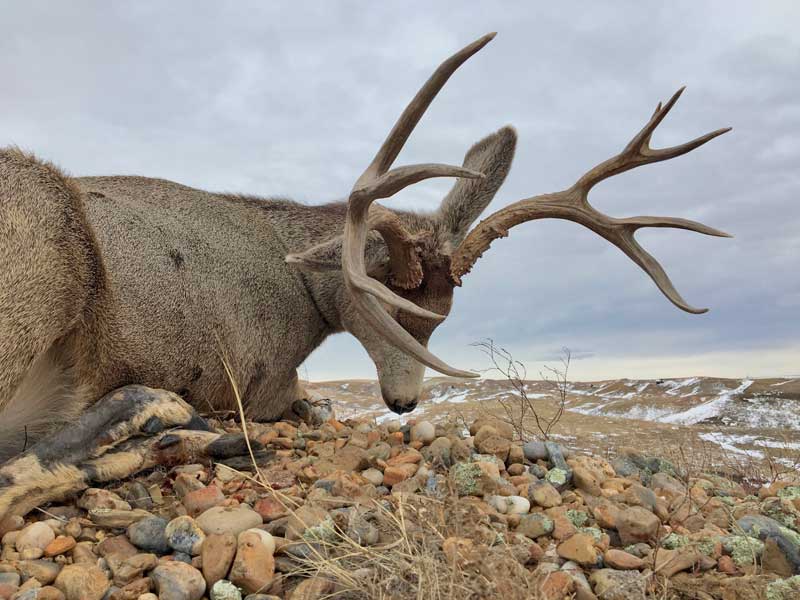
Mule deer seasons usually go from month to month. The last season that was a muzzleloader season was during the month of December. December 31st came and went, and I didn’t have a chance to hunt. Although I’d seen quite a few bucks during muzzleloader season, I hadn’t seen any I wanted to hunt. On December 31st, I called my buddy Domanic Heim and told him, “Well! I guess I’ll eat my muzzleloader mule deer tag this year.” I was surprised when he answered, “You’ve got one more day left to hunt.” I told him, “No, I don’t! Today is December 31st, and that’s when blackpowder season expires,” to which Domanic said, “Read your license.” Sure enough, my license didn’t end until after January 1st. After I checked my license, I called Domanic back and said, “I can’t believe I have one more day to hunt!”
So, Domanic and I met up the next morning on the National Grasslands and went into an area where I’d seen some nice muley bucks earlier in the season. We got to our high point and started glassing, and I spotted this one, lone, big buck. Once the buck bedded-down, Domanic said he would stay on top of the hill and keep glassing the buck, as I tried to stalk in close enough to get a shot. I started my stalk and had to circle him some to get the wind in my favor, but I finally got within 100 yards of this bedded-down muley. The buck stood up and started walking up the side of the hill where he’d been bedded. I was shooting a CVA Optima with a PowerBelt Bullet and 100 grains of powder and had a Vortex Riflescope on my rifle. In South Dakota, we couldn’t use a riflescope with more than 1X magnification during blackpowder season. Then, I missed the buck.
Domanic and I got together, and I said, “I don’t miss, and I sure don’t miss at 100 yards with this rifle.” I assumed that riding my rifle around in my truck during the season, my scope must have lost its accuracy. I aimed at a particular rock on a dirt bank at about 100 yards, and when I squeezed the trigger, I saw that my shot was about 1-1/2 feet low, which is why I shot under the buck. I was heartbroken. I couldn’t believe that on the last day of blackpowder season I’d had an opportunity to take a super nice mule deer buck and missed him. Bummed out about what had happened, I told Domanic, “Let’s go back to the truck.”
To get back to the truck, we had to go down a big drainage. When we were about halfway to the truck, I told Domanic, “I better just go ahead and reload my rifle.” I thought perhaps I’d have a chance to shoot a coyote. About 10 minutes later, we came around a bend in the drainage, and suddenly, this big muley jumped up and started running up the hill. I recognized him as the buck I’d missed earlier. He was circling back toward the same spot where I’d missed him. I immediately dropped to the ground and set up my bipod, as Domanic said, “160 yards!” I aimed a foot above the buck’s back and squeezed the trigger. The buck hunched up before running around another corner of the drainage. I said, “I think I hit him pretty good.” We went 100 yards in the direction the buck was heading and discovered him. When I examined the entry hole, I saw that I had heart-shot the buck. What amazed me was that when I aimed in that split second, I decided that if I shot a foot over that buck’s back, then I should hit him in the vitals. That was exactly what happened. This buck was the third big mule deer buck I’d taken that year.
Bagging a Buck of Another Color – a Whitetail
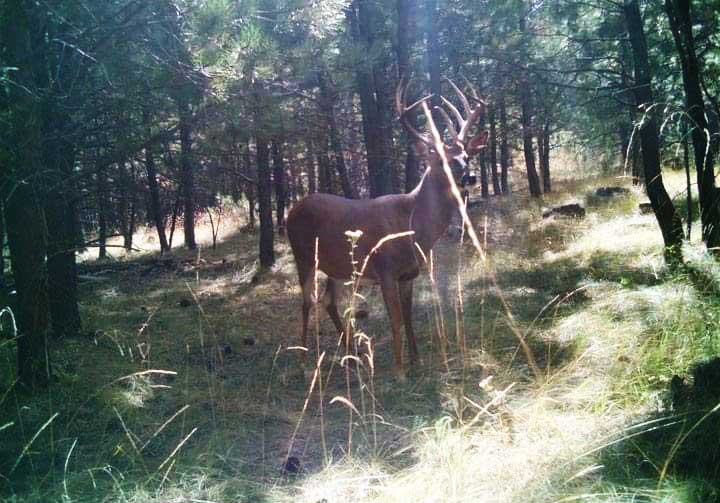
I usually can take a muley with my rifle, my bow or my muzzleloader. If I don’t draw my mule deer tag, I often can get an any-deer tag over the counter. If you get an any-deer tag, and you’ve already taken a mule deer, then that any-deer tag is for a whitetail. We have some great whitetails here in South Dakota, but in the last 5-10 years, most deer hunters have preferred to take mule deer. On this hunt for my whitetail that scored 150, I was hunting U.S Forest Service Land. I’d found this whitetail a month before using trail cameras, and I knew the area where he was hanging out. I’d found a little field behind a rock outcropping that was only 40 yards wide and maybe 50 yards long. From my trail cameras, I’d learned that whitetails fed in this little field before moving into the bigger fields after dark.
I went to my tree stand after work, wearing my scrubs that I wear at the hospital where I work with my Mossy Oak Break-Up Country camo over my scrubs. I’d been in my tree stand for about an hour, stood up, stretched and looked behind my stand. There I saw this big whitetail about 40 yards from me feeding. I grabbed my bow as I saw him walking away and moving through some jack pines. I ranged those, and when he stepped out from behind the trees, I released my arrow. The white-tailed buck only went 30 yards, but the trees were so thick where he was that I never saw or heard him fall. I waited about 30 minutes and called my uncle, who was sitting in a ground blind about 30 yards from my tree stand. I told him I’d just shot that big 6x6 (12-point eastern count) brow-tined buck (each of his brow tines was about 8 inches long). As soon as I got down from my tree stand, I could see a white belly, and I knew my buck was down.

